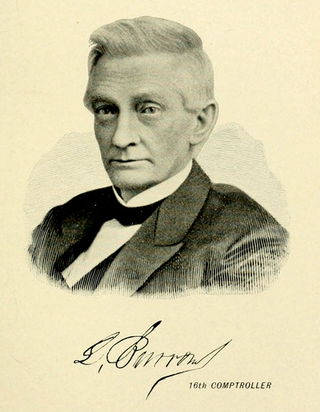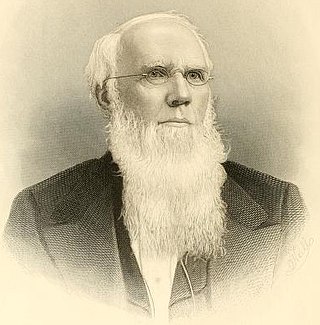
Nelson John Beach (September 21, 1800 Hebron, Tolland County, Connecticut - February 22, 1876 Watson, Lewis County, New York) was an American surveyor, businessman and politician from New York.

Nelson John Beach (September 21, 1800 Hebron, Tolland County, Connecticut - February 22, 1876 Watson, Lewis County, New York) was an American surveyor, businessman and politician from New York.
He was the son of John Beach (1770–1845). The family removed from Litchfield, Connecticut, to Watson, NY, in 1814. He married Emily Porter, and their children were George Byron Beach (d. 1870) and Anna Lydia Beach.
Beach became a land surveyor, and was engaged on the survey of a highway through the wilderness, projected to run from Crown Point on Lake Champlain to Carthage, Jefferson County, New York.
An Act, passed on March 29, 1828, by the New York State Legislature, allowed Nelson J. Beach to erect and exploit a toll bridge over the Black River between Lowville, NY, and Watson, NY.
He was Supervisor of the Town of Watson from 1831 to 1834, from 1837 to 1838, and in 1845. He was a Whig member of the New York State Assembly (Lewis Co.) in 1846, and of the New York State Senate (5th D.) in 1847. Here he advocated the construction of the Black River Canal.
He was one of the first three Canal Commissioners elected in 1847 under the New York State Constitution of 1846, and drew the two-year term, being in office from 1848 to 1849. In 1849, he ran for re-election on the Whig ticket, but was defeated by Frederick Follett. From January 1850 to November 1852, he was a Canal Appraiser. In 1854, he became Vice-President and Superintendent of Construction of the Hudson River Railroad. In 1855, he resigned this post, and accepted the appointment as Resident Engineer on the Eastern Division of the New York State Canals, remaining on the canal work for two years. Afterwards he took charge of the abandoned Ogdensburg, Clayton and Rome Railroad and closed up its affairs.
In 1862, President Abraham Lincoln appointed him Assessor of Internal Revenue for the counties of Jefferson, Lewis and Herkimer.

William Christian Bouck was an American politician from New York. He was the 13th Governor of New York, from 1843 to 1844.
The Commission to Explore a Route for a Canal to Lake Erie and Report, known as the Erie Canal Commission, was a body created by the New York State Legislature in 1810 to plan the Erie Canal. In 1817 a Canal Fund led by Commissioners of the Canal Fund was established to oversee the funding of construction of the canal. In 1826 a Canal Board, of which both the planning commissioners and the Canal Fund commissioners were members, was created to take control of the operational canal. The term "Canal Commission" was at times applied to any of these bodies. Afterwards the canal commissioners were minor state cabinet officers responsible for the maintenance and improvements of the state's canals.

Lorenzo Burrows was an American merchant, banker and politician.

Orville Hungerford was a two-term United States Representative for the 19th District in New York. He was also a prominent merchant, banker, industrialist, freemason, philanthropist, and railroad president in Watertown, New York.

Richard Pratt Marvin was an American lawyer and politician from New York. A Whig, he served in the United States House of Representatives from 1837 to 1841.
Nathaniel Jones was an American banker and politician from New York. He served two terms in the U.S. House from 1837 to 1841.
William Baker was an American lawyer and politician.
Noble Strong Elderkin was an American politician from New York. He was Speaker of the New York State Assembly in 1850.

George Payson Barker was an American lawyer and politician. He was most notable for serving in the New York State Assembly in 1836 and New York State Attorney General from 1842 to 1845.
Orville Luther Holley was an American writer, newspaper editor, historian and politician.
Thomas Clowes was an American lawyer and politician from New York.
Charles Cook was an American politician from New York.

The 1847 New York state election was held on November 2, 1847, to elect the lieutenant governor, the secretary state, the state comptroller, the attorney general, the state treasurer, the state engineer, three Canal Commissioners and three Inspectors of State Prisons, as well as all members of the New York State Assembly and the New York State Senate.
David D. Spencer was an American editor and politician from New York.
Francis Seger was an American lawyer and politician from New York.
George Corlis Sherman was an American lawyer and politician from New York.

The 68th New York State Legislature, consisting of the New York State Senate and the New York State Assembly, met from January 7 to May 14, 1845, during the first year of Silas Wright's governorship, in Albany.

The 70th New York State Legislature, consisting of the New York State Senate and the New York State Assembly, met from January 5 to December 15, 1847, during the first year of John Young's governorship, in Albany.
Samuel Holden Parsons Hall was an American merchant and politician from New York.
Valentine Treadwell was an American farmer and politician from New York.